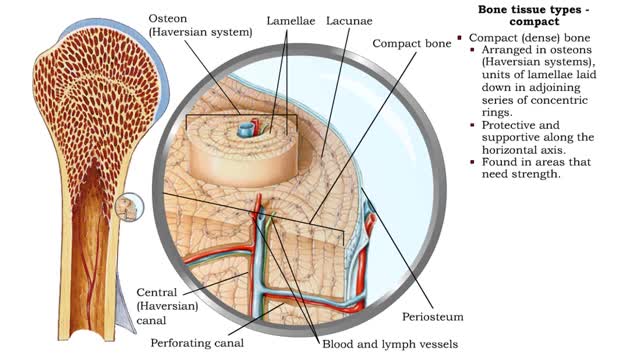Search Results
Results for: 'Passive%20ventricular%20filling'
Acid-base imbalances - compensation of metabolic acidosis and alkalosis
By: HWC, Views: 11222
1. Metabolic acidosis: • Few HC03- ions are present so blood pH becomes acidic. • Compensation is increased respiratory rate and more CO2 is removed from the blood. • Blood pH returns to normal. 2. Metabolic alkalosis: • Many HC03- ions are present so blood pH becomes alkaline...
Acid-base imbalances - compensation of respiratory acidosis and alkalosis
By: HWC, Views: 11261
• When one pH balancing system is affected then the other balancing system attempts to correct, or compensate for, the pH imbalance. - Respiratory acidosis: • Excessive CO2 is present so blood pH becomes acidic. • Compensation is increased secretion of H+ into urine and reabsorption ...
Bone tissue types - compact and spongy
By: HWC, Views: 11025
Bone tissue types • There are two types of bone tissue: compact and spongy. • All the bones of the skeleton have both kinds of bone tissue. • Compact (dense) bone • Arranged in osteons (Haversian systems), units of lamellae laid down in adjoining series of concentric rings. • P...
Facilitated Diffusion - Glucose transport
By: HWC, Views: 11284
Transmembrane proteins help solutes that are too polar or too highly charged move through the lipid bilayer The processes involved are: Channel mediated facilitated diffusion Carrier mediated facilitated diffusion In facilitated diffusion, molecules only move with the aid of a protein i...
Osmosis - Isotonic, Hypotonic, and Hypertonic Solutions
By: HWC, Views: 11130
Isotonic: Equal Water moves in and out of the cell at an equal rate. The cell remains unchanged. Hypotonic: "hypo" hippo Water moves into the cell, making it swell and get fat (like a hippo). Eventually the cell can rupture and burst (aka lyse). Hypertonic: "like a raisin" Water leaves...
Molecules, Membrane Permeability and Structure
By: HWC, Views: 10489
Organisms are not isolated system at equilibrium and need to intake nutrients and electrolytes as remove wastes. Similarly Cells within an organism must also exchange compound by passing them through membrane. The permeability of a membrane is the rate of passive diffusion of molecules th...
Role of the respiratory system - effect of altered ventilation rates
By: HWC, Views: 11627
• The respiratory system regulates blood pH by controlling the amount of carbon dioxide removed from the blood. • Near systemic cells, carbon dioxide forms bicarbonate ions in the blood. H+ ions are also released, thereby decreasing blood pH. • At the alveolar capillaries, bicarbonate io...
By: HWC, Views: 11183
Osmosis is the flow of water down its concentration gradient, across a semi-permeable membrane. Osmosis is an example of diffusion, which is when molecules tend to distribute themselves evenly in a space. what is a semi-permeable membrane? It is a membrane or barrier that allows some molec...
By: HWC, Views: 11023
Exocytosis is another method of vesicular transport that moves large volumes Of fluid or chemicals out of the cell. It is a process by which a cell transports secretory products through the cytoplasm to the plasma membrane. A examples of cellular secretory products: 1. Secreted protein - enzym...
Advertisement











